It’s no secret that Butterkase cheese is a beloved delicacy worldwide.
It has a delightful flavor and its rich, buttery texture makes every meal feel complete.
Unfortunately, it can be difficult to source for those who don’t have access to their local specialty market.
The good news is that several options to substitute for Butterkase cheese are available.
In this blog post, we’ll provide some alternatives so you won’t miss out on all that cheesy goodness!
What Is Butterkase Cheese?
Butterkase cheese is an American-style, semi-soft cheese that was developed in Wisconsin.
It has a smooth, creamy texture and a nutty, buttery flavor.
The inner paste of Butterkase cheese has tiny irregular holes formed by pockets of carbon dioxide, which were created during the fermentation process.
This cheese melts very well and can be used for various dishes. It is commonly used in sandwiches, burgers and pizza for a cheesy flavor.
Butterkase cheese can also be grated or melted over casseroles, macaroni and cheese or as a finishing touch to baked potatoes, steamed vegetables, and omelets.
Its mild flavor makes it great for adding a creamy richness to sauces and soups.
The flavor and texture of Butterkase cheese also pair well with various types of meat, including ham, bacon and sausage.
Finally, it is often served as an appetizer or snack with crackers, pretzels or fresh fruit.
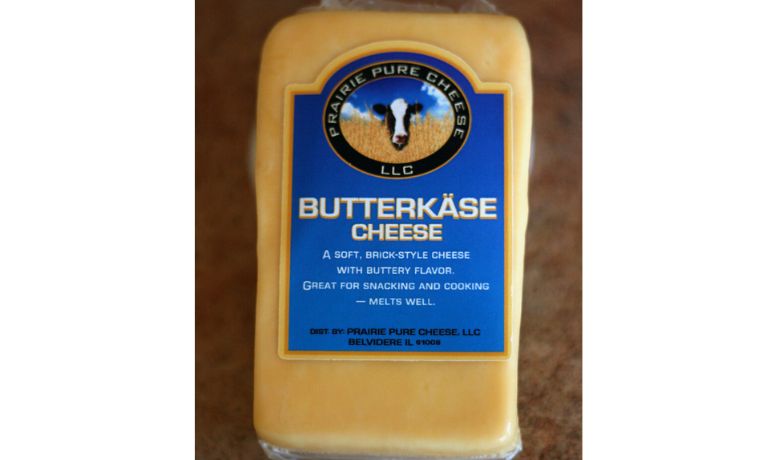
Substitutes For Butterkase Cheese
Though Butterkase cheese is unique and flavorful, many delicious alternatives can be used in recipes or as a snack.
Beaufort Cheese
Beaufort cheese is a firm, cooked, pressed cheese made with raw cow’s milk from the Savoie region of France.
It is produced in large rounds and has a semi-hard texture with an amber-colored rind.
Beaufort cheese has a fruity yet nutty flavor, often compared to Gruyere or Comte cheeses.
It is usually aged for 6-9 months, resulting in a dense texture and savory flavor.
Beaufort cheese is often used as a table cheese but can also be grated over salads, pasta dishes, omelets, and quiches.
It is also commonly used to make fondue or melted into sauces and soups.
Its flavor pairs well with many wines, particularly those from the Jura region of France.
The cheese also goes great with fruits like apples, pears, or grapes.
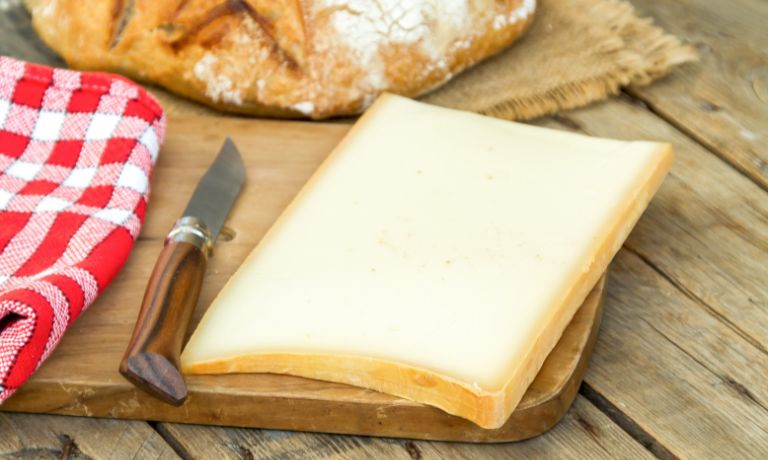
Emmental Cheese
Emmental cheese is a yellow, medium-hard cheese originating in the Emme Valley of Switzerland.
It has a sweet, nutty flavor with small, irregularly shaped holes scattered throughout the cheese.
The aging process for Emmental Cheese can range from three months to twelve months and beyond.
Due to its mellow but flavorful taste, Emmental cheese is often used in fondues and other melted dishes.
It can also be grated onto salads, sandwiches, pasta, potatoes, or pizza.
When heated, it becomes creamy and pairs well with vegetables, meats, and other cheeses.
In addition to being eaten on its own or as part of a dish, Emmental cheese can also be used as an ingredient in baking.
It adds creaminess and flavor to bread, cakes, and pastries.
It can be used as a topping for gratins or casseroles and a filling for omelets or quiches.

Fontina Cheese
Fontina cheese is a semi-soft Italian cheese made from cow’s milk.
It has a natural rind and a creamy texture, with an earthy nutty taste that strengthens as the cheese ages.
Fontina cheese has existed since the 16th century and is a popular part of Italian cuisine today.
Fontina is most commonly used to melt on pizza or other dishes, in sauces and sandwiches.
It pairs well with meats such as ham, prosciutto, and salami.
Fontina is also a great addition to fondue or even pasta dishes. It can also be enjoyed as an appetizer with crackers or sliced apples.
Fontina cheese is available in wedges, wheels, and pre-sliced packages.
It can be found in most grocery stores, specialty cheese shops, and online.

Gouda Cheese
Another option to substitute for Butterkase cheese is gouda cheese.
Gouda cheese is a semi-hard cow’s milk cheese named after the Dutch city of Gouda.
It is one of the most popular cheeses in the world, with a mild buttery flavor.
The outer rind can range in color from yellow to red to black, depending on the type of wax used during its production.
This cheese is often used as a table cheese, for melting into sauces and soups, and as an ingredient in grilled sandwiches.
It can also be aged to enhance its flavor, which results in a sharper taste.
Gouda is especially delicious when paired with fruits or nuts.

Gruyere Cheese
Gruyere cheese is a popular Swiss cheese with a nutty flavor and creamy texture.
It’s usually aged for around six months to two years, giving it its distinctive flavor.
Gruyere cheese can be enjoyed as part of a charcuterie board, melted on toast, or in quiches and gratins.
It also adds complexity to sandwiches and salads. This cheese pairs well with beer, wine, and fruits such as apples or pears.
It is also an excellent ingredient to use in cream-based sauces and soups.
Its robust flavor makes it a great cheese for grilling and roasting on pizzas, burgers, or steak.
Try using Gruyere cheese instead of cheddar or mozzarella for a unique twist on macaroni and cheese.
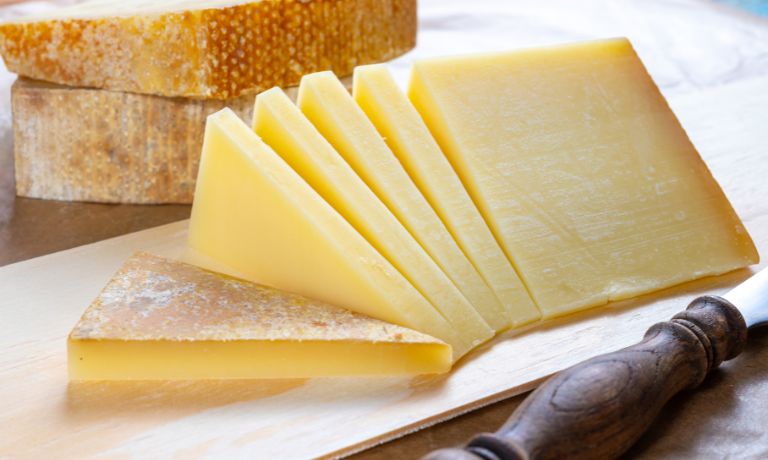
Raclette Cheese
Raclette cheese is a semi-firm cow’s milk cheese from the Swiss Alps. It has a strong aroma and a creamy, nutty flavor.
Raclette is typically served melted on potatoes or other vegetables, in sandwiches, and sometimes just eaten as is.
It can also be grated into fondue dishes or used in sauces and soups.
Raclette is a great cheese to add a unique flavor to dishes, and it’s versatile enough that you can find creative ways to use it in your cooking.
Whether you serve it melted on vegetables or grated it into sauces, raclette will surely be an interesting addition to your meal.
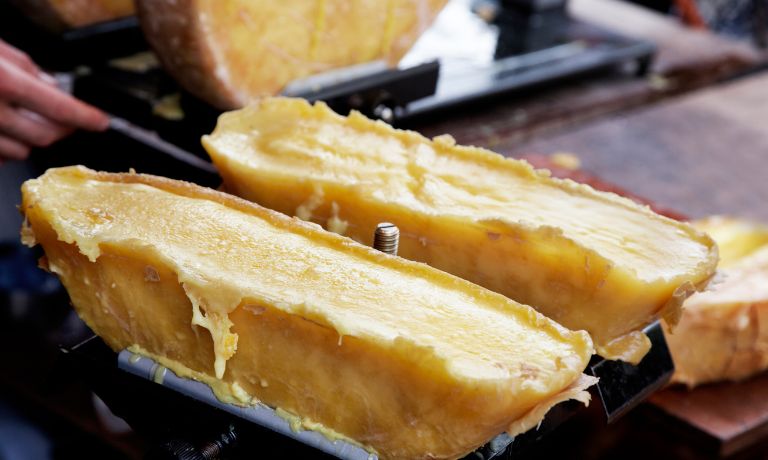
Havarti Cheese
Havarti cheese is a semi-soft cow’s milk cheese originating from Denmark.
It has a buttery, creamy texture with small irregular openings that contain a mild, almost sweet flavor.
Havarti can be found in various forms, such as aged, smoked or flavored with caraway, dill, jalapeno, and garlic.
The cheese pairs well with red and white wines, making it a great addition to any cheese plate.
Havarti can be melted on top of vegetables or sandwiches, added to fondue or quiche, paired with crackers and fruits, and blended into sauces for a creamy texture and flavor boost.
It also melts well in baked dishes, giving a deliciously gooey texture.
For those who enjoy the flavor of Havarti, it can also be enjoyed as a snack on its own.
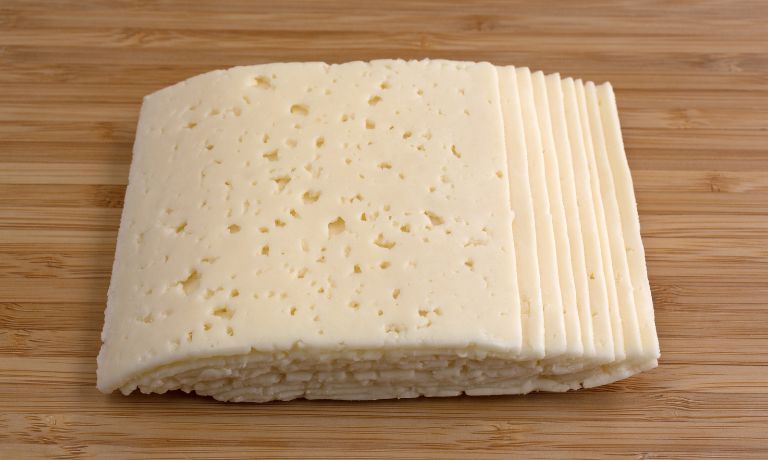
FAQs
Can Cream Cheese Replace Butterkase Cheese?
Yes, cream cheese can be used as an alternative to Butterkase cheese in many recipes.
Cream cheese is softer and milder than Butterkase, so it may not have the same flavor profile but can still make for an excellent substitution.
Can Cheddar Cheese Replace Butterkase Cheese?
Cheddar cheese can be used as an alternative to Butterkase cheese in many dishes.
Cheddar has a stronger flavor than Butterkase, which may overpower some recipes.
To get the best results, use an equal amount of cheddar as you would Butterkase and adjust any other ingredients to taste.
Can Brick Cheese Replace Butterkase Cheese?
Yes, Brick cheese can be used as an alternative to Butterkase cheese in many recipes.
It is very similar in flavor and texture but has a firmer consistency than Butterkase cheese.
Brick cheese also melts better and faster than Butterkase cheese, so it may be preferred when making macaroni and cheese or grilled sandwiches.
Conclusion
Butterkase cheese is a semi-soft cow’s milk cheese with a buttery flavor and creamy texture.
This flavorful cheese is perfect for melting on top of dishes or using it in cooking.
While it may be hard to find, there are several other options to substitute for Butterkase cheese for a similar flavor and texture.
These include Beaufort, Emmental, Fontina, Gouda, Gruyere, Raclette and Havarti.
Each cheese has its unique flavor, making them great for adding complexity to dishes or simply enjoying themselves.
With the right combination of flavors, you can turn any dish into a gourmet experience!

